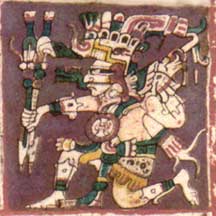| THE DRESDEN CODEX We learned the Dresden when we hear of Johann Christian Götze, Director of the Royal Library in Dresden, won the codex private owner in Vienna in 1739. In 1744, Götze gave it to the Royal Library, where he still resides. (The library's current name is Saxon Landesbibliothek). But not everything has been "very easy" for Dresden, during the bombing of World War II Dresden had severe water damage. Therefore, previous facsimiles World War are still very informative for study purposes. The following list includes some of the most interesting copies and facsimiles have been produced: |  |
1. In 1810, Alexander von Humboldt published "Vues des Cordillères". This work includes pages 47, 48, 50, 51, 52 of Dresden in a very beautiful color, but not entirely accurate. I've seen copies of this book for sale up to $ 93,000, and for as little as $ 25,000, so it's a bit expensive, and it really is a collector's item.
Two. In 1825 or 1826, one Italian, Agostino Aglio, made a tracing of the Dresden Codex for the Lord Kingsborough. It was in black and white, but was used in "Antiquities of Mexico" the Lord Kingsborough published in 9 volumes (the last two posthumously; Kingsborough died of typhus in the prison of debt. Accumulated debt in part by these publications). The Lord Kingsborough had the Dresden version prepared Aglio color for Volume III, in 1830 or 1831. Apparently it was colored by hand because not all pages with the same number of different copies are identical. (The pictures of Justin Kerr of Kingsborough are available below)
Three. In 1880, and again in 1892, Ernst published Förstemann Dresden in photochromolithographic editions, with perhaps only 60 copies produced in each issue (Gates, booklet with "The Dresden Codex", 1932). These have become extremely rare, and have never seen a copy of 1880 or 1892 for sale. Fortunately, the late Linda Schele tried to get your own copy, a gift from Floyd Lounsbury, become readily available. She not only provided a copy Förstemann FAMSI of Dresden, but also to the Press Cholsamaj in Guatemala. Cholsamaj published facsimile versions may still be available by contacting: cholsamaj@fundacioncholsamaj.org. The Förstemann copy is available below.
J. Eric Thompson relied heavily Förstemann the photos to make your version of Dresden (published in "A Commentary on the Dresden Codex", Philadelphia, 1972). Lips and Deckert also made their version of the Dresden Codex using Förstemann editions (1962, Berlin). Andreas Fuls has made available a CD (for $ 20 from April 2002) of the personal copy of Förstemann, now housed in the Ibero-American Institute in Berlin.
April. In 1959, Ian Graham visited Dresden and made slides of the Dresden Codex (personal communication: October 17, 1998). In this collection of slides, I have seen only one print: a very beautiful part of page 49 of the Dresden, in a book entitled "Vanished Civilizations of the World" (editor: Edward Bacon, Thames and Hudson, McGraw-Hill, 1963).
May. In 1932, William E. Gates released a facsimile version of Dresden. It looks great, is colorful and has its own type-font for all glyphs. I can not say that is the most accurate, but it is nice to see. He says he produced 75 copies (Gates, booklet "The Dresden Codex", 1932), but I've noticed some copies of this edition unnumbered may have been placed along with extra printed sheets that were later collected by students (personal communication March or April 1997 Jeremiah F. Epstein, who was a professor in the Department of Anthropology at the University of Texas, Austin).
June. In 1975, the Akademische Druck-u. Verlagsanstalt, Graz, Austria, printed a facsimile of the original color photos that was damaged during the Second World War, with commentary by Helmet Deckert and Ferdinand Anders. It is remarkably good, and the worst of the damaged pages have been reproduced again from Förstemann in a separate booklet that accompanies it. This along with a copy of Chiapas (in the book by Thomas A. Lee, Jr., "The Maya Codices", 1985) have been used as an important support for Mayanists from their publications.
Because the Dresden was in pieces in previous years, the Europeans subsequently assigned numbers to the pages, the codex subsequent studies later proved to be incorrect. The page numbers are kept pretty much the same, however, with the knowledge that the order of the pages within the codex was probably 1-24, 46-74 and 25-45.
